Mitzub'ixi Qu'q Ch'ij
Source: Ikeda, Mitsuho, 2020, Repatriation
of human remains and burial materials of Indigenous peoples in Japan :
Who owns their cultural heritages and dignity? CO*Design, 7:1-16. info:doi/10.18910/75574
Direct downlod from our internet cite: cod_07_001X.pdf without password
After ratification
of the UNDRIP, United Nations Declaration on the Rights of Indigenous
Peoples by Japanese government in 2007, the Ainu minority began to
promote repatriations of human remains and burial materials that had
been collected -- "pillaged" explaining by the Ainu activists -- and
maintained in Japanese universities, chiefly national ex-imperial
universities as "academic purposes" from collected tombs and
archaeological sites in Hokkaido.
Today the debate
of translocation of US military base in southern Japan, Okinawa evokes
the rising Ryukyuan nationalism and also similar with the Ainu
repatriation thought and methodology with the among the Ryukyuan. The
concepts of repatriation of human remains can challenge us to rethink
modernist thought on collective property and ownership.
I will discuss the
ethical, legal, and social aspects of the
debates regarding the Rykyuan human remains between scholars, lawyers,
and civil activists (so called "plaintiff") and Japanese mainland
universities officials ("defendant"). These disputes come to a
deadlock. The plaintiffs want to establish the collective entitlement
of indigenous rights for the repatriation that has not been enacted on.
The defendants reject their demands legal conformity of "successors to
the rituals of the family" according to present Japanese civil laws.
From this actual
debate, we, cultural anthropologist should ask a series of questions
mentioned below;
1. What is the concept
of property or repatriation of human remains and burial materials?
2. What is the
collective human rights of Indigenous peoples?
3. Why do
indigenous people ask to have both collective human rights and
repatriation their "ancestral" heritage from universities?
4. What is the
difference of property right among indigenous people from ordinary
neighborhood citizen?
The speaker
will
relativize modern property rights and disposable rights and advocate
what the repatriation rights of indigenous people in the
anthropological point of view.
*Credit:
the paper [will be] presented at Spring meeting of the Korean Society
of Cultural Anthropology, April 26, 2019.
한국문화인류학회
2019년 춘계학술대회,
땅과 인간 : 소유와
공유, 죽임과 살림, 재생과 건설
2019.
4.26.(금) 09:30 | 서울대학교 아시아연구소 101동 210호 영원홀
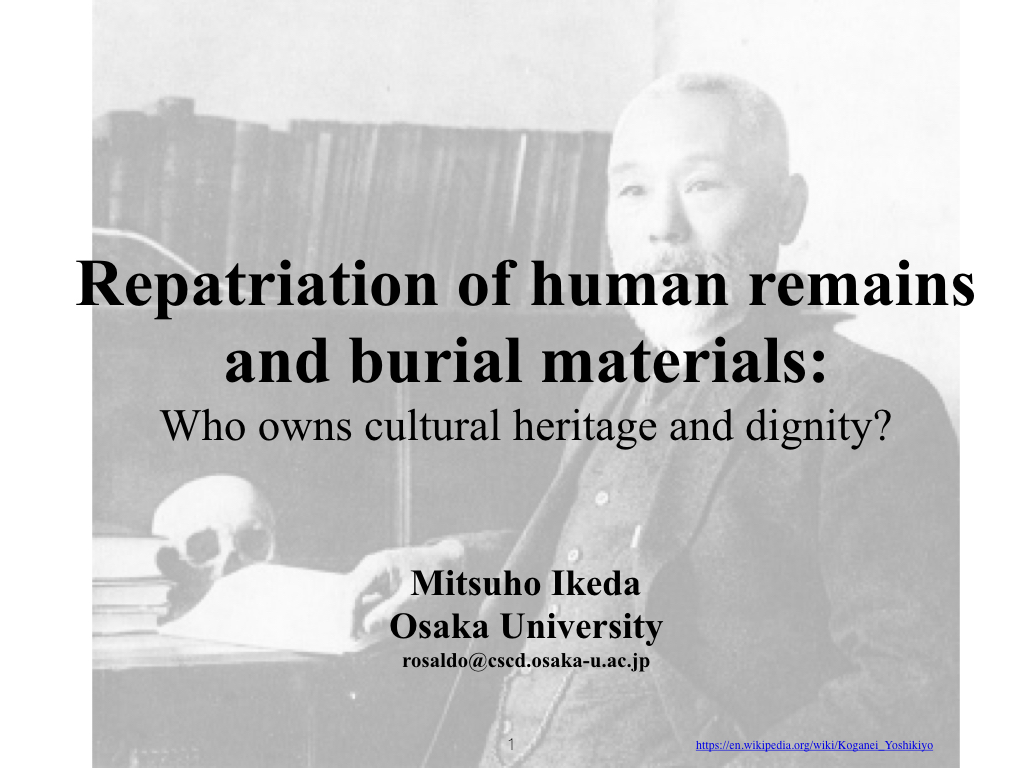
|
1 Repatriation of human remains
and burial materials:
Who owns cultural heritage and dignity?
|

|
2
• Following the ratification of
UNDRIP, the United Nations Declaration on the Rights of Indigenous
Peoples by the Japanese government in 2007, the Ainu, one of Japan’s
ethnic minorities, began to promote the repatriation of human remains
and burial materials. These had been collected, or “pillaged” according
to Ainu activists, and maintained in Japanese universities, chiefly
national ex-imperial universities for “academic purposes,” following
their collection from tombs and archaeological sites in Hokkaido.
• In this meeting of the Korean
Society of Cultural Anthropology, the main subject is “Land and
Tenure,” that explores the broad sense of property, entitlement, and
ownership of an area, domain, space, and territory. During my
presentation, I will focus on socio-cultural concepts of property in
the context of the repatriation of indigenous people’s human remains.
|

|
3
• 1. what concept of property is
involved in the repatriation of human remains and burial materials?
• 2. what are the collective human rights of Indigenous people?
• 3. why do Indigenous people ask
to have both collective human rights and to repatriate their
“ancestral” heritage from universities?
• 4. how are Indigenous people’s
property rights different from those of Non-Indigenous ordinary people?
|

|
4
• 1. Introduction
• 2. Brief History of the Repatriation Claims
• 3. Stories of Bones
• 4. Quest for harmony between plaintiffs and defendants
• 5. Concluding remarks
• My conclusion will explain that
Indigenous people’s desire for the repatriation of human remains refers
to their need to reclaim objects to recover from violent colonial
trauma, and to the need for a homecoming to their time and place of
origin. This ideology is represented in their ritual of returning, a
ceremony that they originally invented.
|
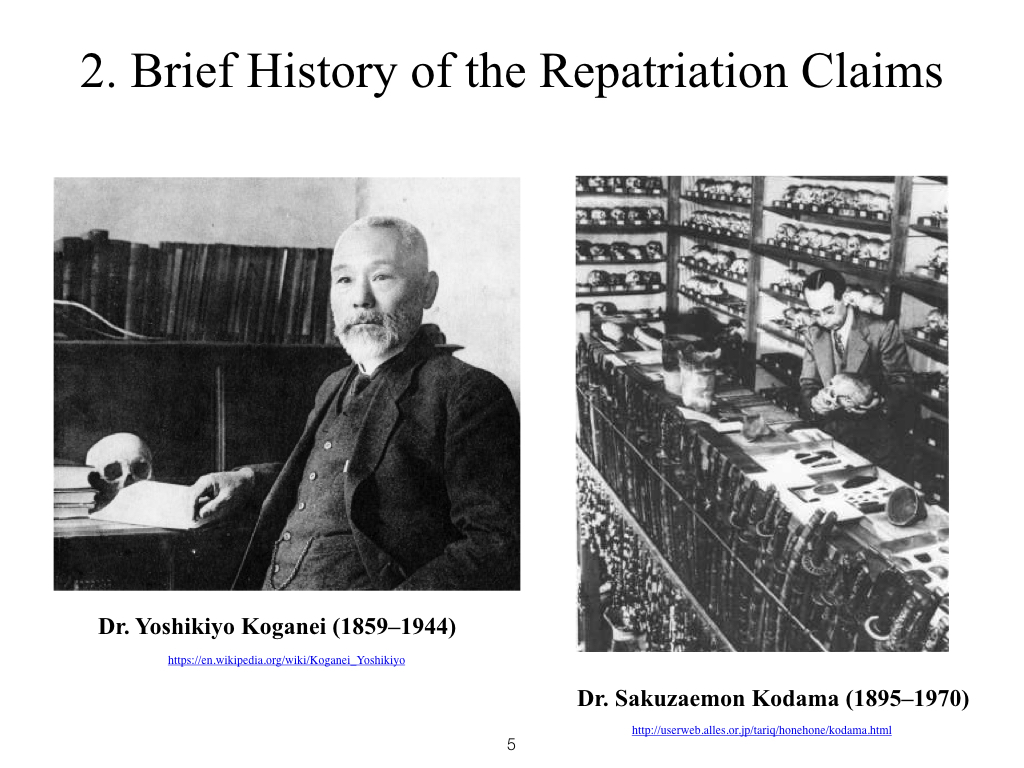
|
5
Dr. Yoshikiyo Koganei (1859–1944)
Dr. Sakuzaemon Kodama (1895–1970)
|
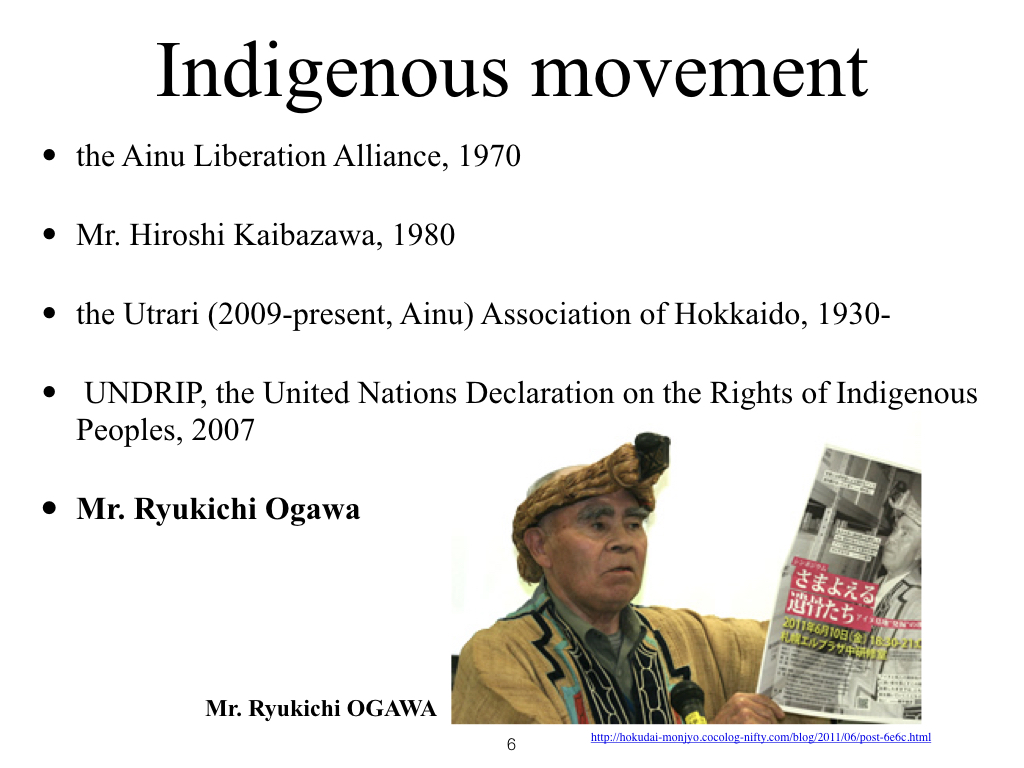
|
6
• the Ainu Liberation Alliance, 1970
• Mr. Hiroshi Kaibazawa, 1980
• the Utrari (2009-present, Ainu) Association of Hokkaido, 1930-
• UNDRIP, the United Nations Declaration on the Rights of Indigenous Peoples, 2007
• Mr. Ryukichi Ogawa
|
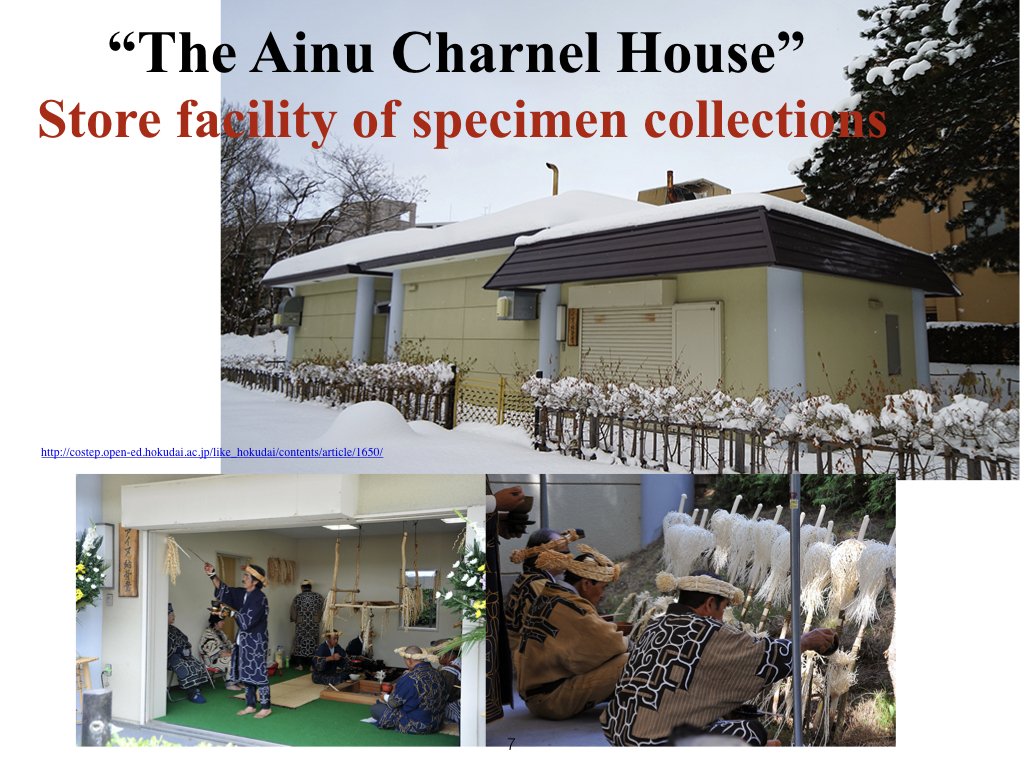 |
7
“The Ainu Charnel House”
Store facility of specimen collections
|
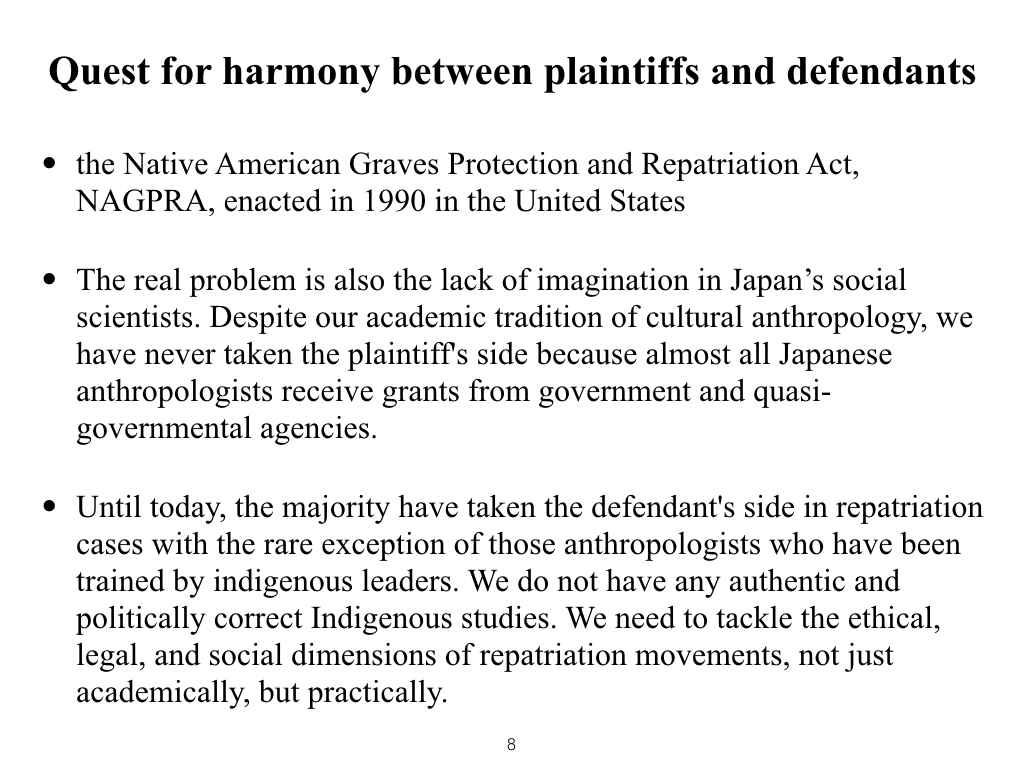 |
8
• the Native American Graves
Protection and Repatriation Act, NAGPRA, enacted in 1990 in the United
States
• The real problem is also the
lack of imagination in Japan’s social scientists. Despite our academic
tradition of cultural anthropology, we have never taken the plaintiff's
side because almost all Japanese anthropologists receive grants from
government and quasi-governmental agencies.
• Until today, the majority have
taken the defendant's side in repatriation cases with the rare
exception of those anthropologists who have been trained by indigenous
leaders. We do not have any authentic and politically correct
Indigenous studies. We need to tackle the ethical, legal, and social
dimensions of repatriation movements, not just academically, but
practically.
|
 |
9
• A legislative repatriation
process does not objectively protect the Indigenous people’s human
remains. For government officials, human remains should be treated as
objects that must be returned to the appropriate stakeholder.
Indigenous people insist that human remains are not property but a part
of a whole body, a painful body, and a mindful body that will never be
recuperated.
|
 |
10
• Even now, the government does
not approve of the collective rights of Indigenous people as recognized
by UNDRIP, the United Nations Declaration on the Rights of Indigenous
Peoples. Indigenous people always possessed a shared sense of
collective rights before the UN began to discuss them.
|
 |
11
• Because there is a significant
interrelationship between collective human rights and repatriation of
their “ancestral” bodies, Indigenous people have naturally accepted the
newly emerging concept of indigenous collective rights.
|
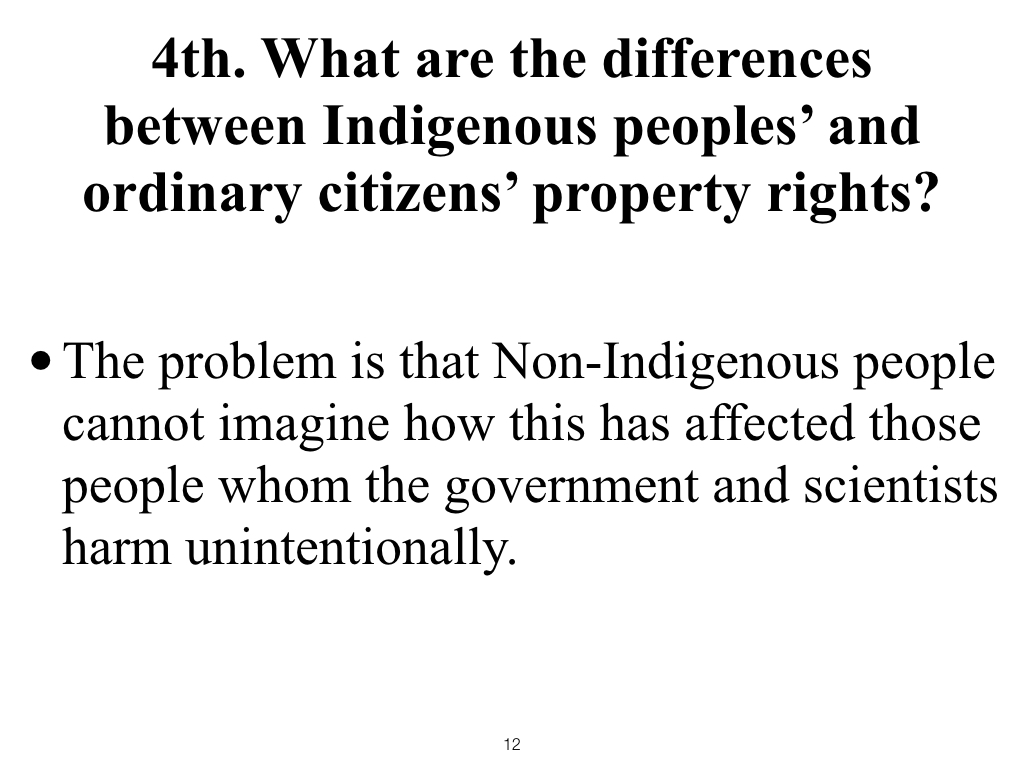 |
12
• The problem is that
Non-Indigenous people cannot imagine how this has affected those people
whom the government and scientists harm unintentionally.
|
 |
13
• Indigenous people (plaintiffs)
insist that human remains are not property but a part of a whole body,
a painful body, and a mindful body that will never be recuperated.
• For government
officials(defendants), human remains should be treated as objects that
must be returned to the appropriate stakeholder.
• My conclusion is that the
repatriation requests of Indigenous people involve not only returning
objects but also their recovery from violent colonial trauma, which
requires a sense of homecoming to the time and place of origin.
|
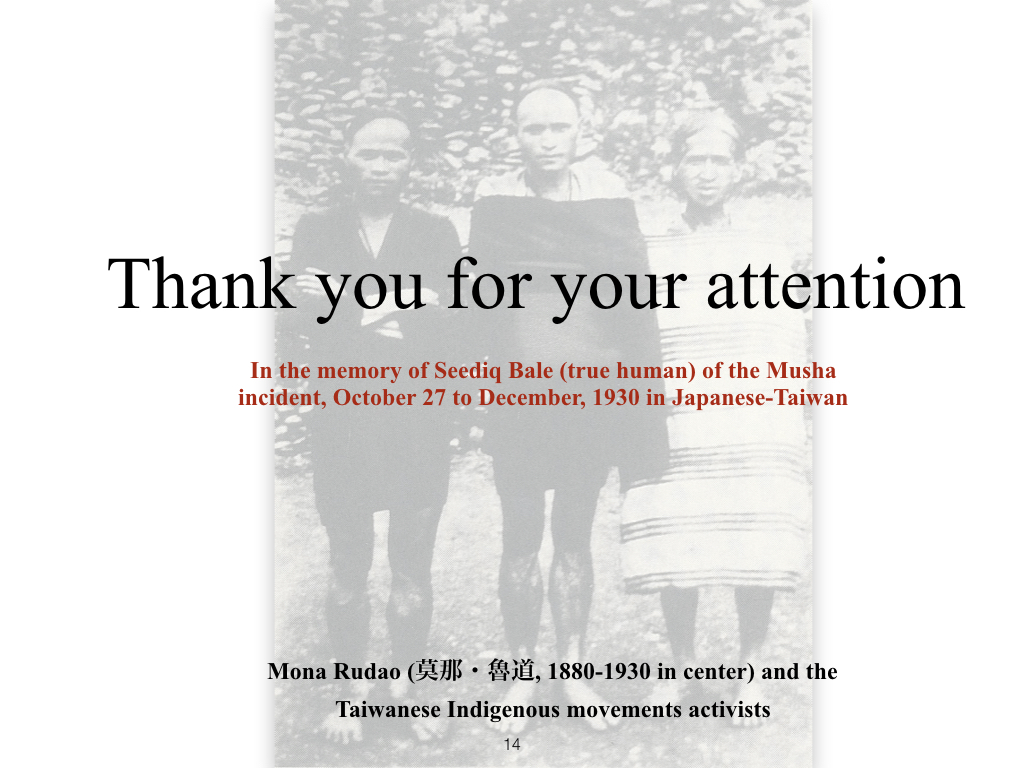 |
14
In the memory of Seediq Bale (true human) of the Musha incident, October 27 to December, 1930 in Japanese-Taiwan
Mona Rudao (莫那・魯道, 1880-1930 in center) and the Taiwanese Indigenous movements activists
|
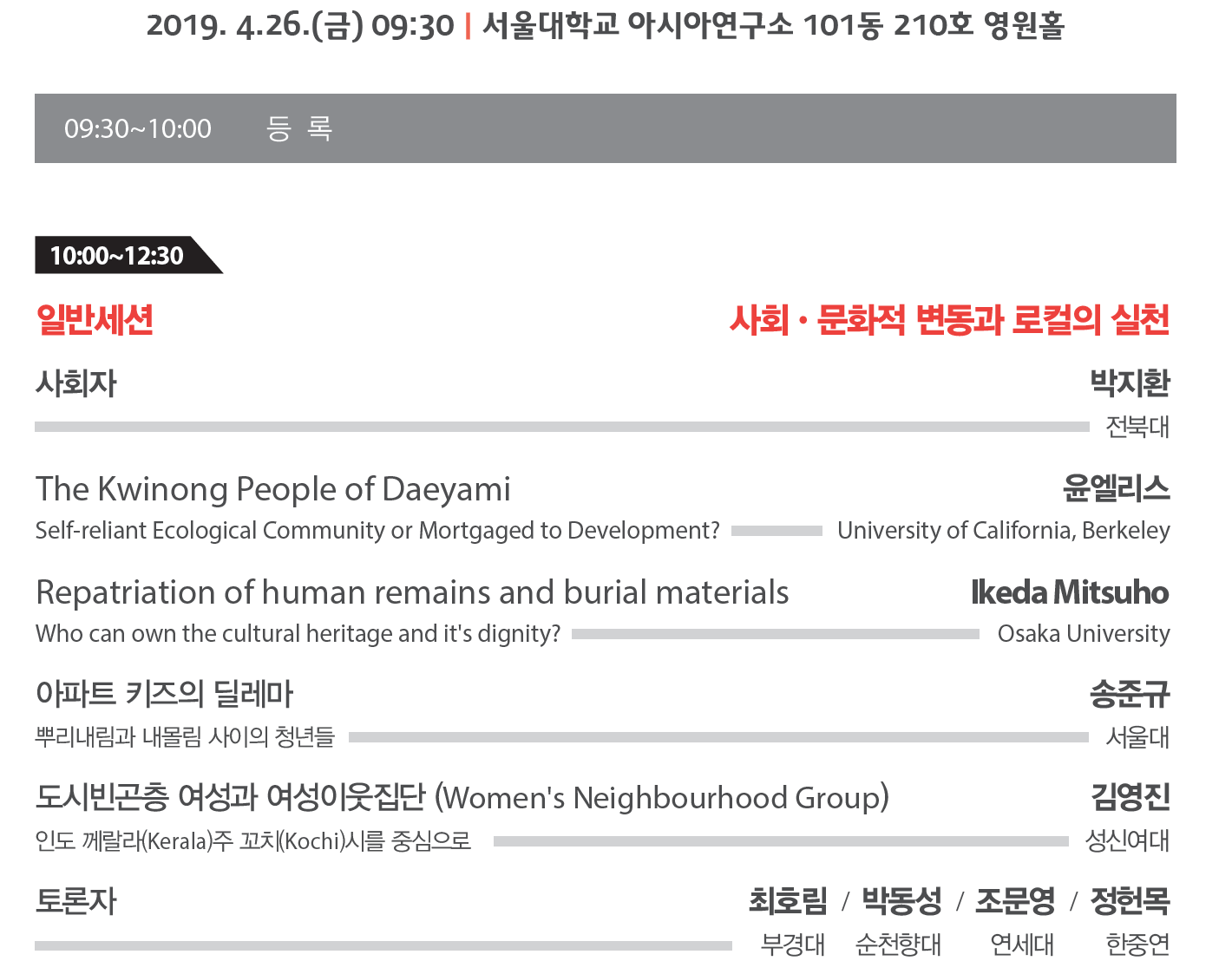
“Stealing remains is criminal”:
Ethical, Legal, and Social Issues of “scientific research” on the
repatriation of human remains to Ryukyu islands, southern Japan
In December 4, 2018, an activist group which claims indigenous rights
has filed a lawsuit against Kyoto University for return of the remains
of royal Ryukyuan Mumujana tomb in Nakijin village. In this
presentation, I will analyze the debates regarding the Rykyuan human
remains among scholars, lawyers, and civil activists and Japanese
university authority in terms of ethical, legal, and social aspects.
The leader of activist group and his followers share the political
ideology of independence of Ryukyu island as ethnic entity from
mainland Japan. Their style of claiming for repatriation is influenced
by the Ainu indigenous activism in northern Japan. Based on the codes
of the definition of UNDRIP indigenous people the Ryukyuan activists
have been formulating collective rights of indigenousness. The
university authority delays the response to their claims because the
authority always inquires the official response by central government
office. At the moment, these disputes come to a deadlock. The
indigenous activists want to establish the collective entitlement of
indigenous rights for the repatriation of remains that has not been
enacted on. The university officials reject their demands in terms of
legal conformity of “successors to the rituals of the family” congruent
to present Japanese civil laws. The royal descendants of Ryukyu family
as well as activists are claiming that royal remains should be
repatriated with compensations and finally be re-buried in traditional
aerial sepulture. From these debates and disputes, we should ask
a series of questions such as; 1. What is their concept of property or
repatriation of human remains and burial materials? 2. What is the
collective human rights of indigenous peoples? 3. Why do indigenous
people ask to have both collective human rights and repatriation of
their “ancestral” heritage from universities? and 4. What is the
difference of property right among indigenous people from ordinary
neighborhood citizen?
|
Links
- “Stealing remains is criminal”:
Ethical, Legal, and Social Issues of the repatriation of human remains
- KAYOKO KIMURA, Japan's indigenous Ainu sue to bring their ancestors' bones back home, The Japan Times, JUL 25, 2018
- Repatriation of Historic Human Remains - Library of Congress, AUSTRALIA (pdf)
- Native American Graves Protection and Repatriation Act, Wiki
- Museums are returning indigenous human remains but progress on repatriating objects is slow, The Conversation, December 1, 2016 6.29pm AEDT
- David Shariatmadari, ‘They’re not property’: the people who want their ancestors back from British museums. The Gardian, Apr.23, 2019.
- Reclaiming Identity: The Repatriation of Native Remains and Culture, Friends Comittee, March 17, 2008
- Human remains, Departemnt of Aboriginal and Torres Strait Islanders Partnerships, Queensland Government.
- United Nations Expert Mechanism on the Rights of Indigenous Peoples 8th session, 20 – 24 July, 2015.(pdf)
- Repatriation and the disposition of the dead, Encyclopedia Britanica.
Bibliography
other informations

